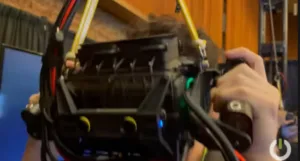Meta has been working on many aspects of VR and AR display use for years. At Siggraph this year the firm showed its experiments with pushing the brightness of VR headsets to new levels. UploadVR interviewed Douglas Lanman, Display Systems Research Director at Meta about the development and one comment that he made struck home with me.
Lanman talked about seeing the famous Dolby 10,000 cd/m² test rig that it used when developing its concepts for HDR and where the PQ curve used in HDR was developed.
For those that aren’t aware of the background, Dolby wanted to get a real understanding of what viewers would like to see if there were ‘no limits’. At the time, the standard kind of electronic display was a CRT with very low levels of luminance and even the new LCDs could have higher brightness, but still just in the ‘hundreds of nits’ range. So Dolby set up an LCD that used a large installation projector as the backlight. That allowed viewers to adjust the brightness of the display up to the 10,000 cd/m² level if they wanted to. What is surprising to those of us that have looked at very bright displays is that some viewers really did like the high brightness.
Of course, the visual system is complex and although it has long been understood that, in simple terms, the eye uses ‘rod’ cells to see in low light and ‘cones’ in higher light and that means that how we see depends on the level of light. However research in Japan has shown that a third type of cell (retinal melanopsin cells) also seems to influence how brightness is perceived. The perception of brightness is also affected by the level of saturation in the colours that we see – the Helmholtz–Kohlrausch (H-K) effect. What this all means is that the way we see bright things is very different to the way we see darker things. And, of course, the eye adapts to different levels of brightness over time.
Meta has been looking at this aspect of head-mounted displays, along with others such as the vergence/accommodation conflict and resolution. The different aspects are:
- focus and accommodation issues – Half Dome 3 is the latest prototype
- Resolution – Butterscotch gets to 55 ppd
- Size of the headset – Holocake 2
- Optical distortion (no prototype, yet)
To further dig into luminance effects, it has developed what it calls the Starburst headset and that’s what it showed at Siggraph. Based on Lanman’s enthusiasm for the 10,000 cd/cd/m² test rig Dolby test rig, the prototype was developed to generate up to 20,000 cd/m². That’s ten times brighter than the best home TVs and 80 times brighter than typical desktop monitors and notebooks. However, it’s still nowhere near the level of brightness that we see in direct full sunlight.
Meta is working towards what it calls the ‘Visual Turing Test’ which is to say, showing an image that appears to be real and not virtual. As NHK found, when Dr Masaoka tried to see how much resolution you need to convince people that objects are real and came up with 8K resolution as a result, convincing people that they are seeing reality when they are not is hard. High brightness is part of that.
As we have talked about a lot on Display Daily, contrast and dynamic range are also key areas in compelling visuals. Lanman admitted that the Starburst system cannot get down to the very low levels of black that are available in the best OLED displays, but can get down to the level where they are seen as black. The 2560 x 1620 displays are LCDs and the headset uses a dual layer concept with a separate LC layer modulating the backlight. It is also not practical as an HMD as it weighs 2.5kg and so was demonstrated in a tethered mode with a balancing weight at the show. (there’s a nice ‘walk past’ video of the exploded headset here)
Although the headset can’t get to the deepest blacks, it is capable of showing bright shafts of light and Lanman highlights that all the different optical elements of an HMD has contrast-limiting issues.
“Everything fights with everything else”
He clarified that the limit of contrast is currently determined by the optics and not by the display itself. He also highlights that it’s not just the display engineers that are going to solve all the issues, but those involved in content and graphics as well.
Each of the headsets that Meta has developed pushes at just one parameter and Lanman pointed out that what we really want to see is the Venn diagram where you have all the features of each of the different prototypes. However, what is clear is that we’re still quite a long way from achieving this. (BR)



